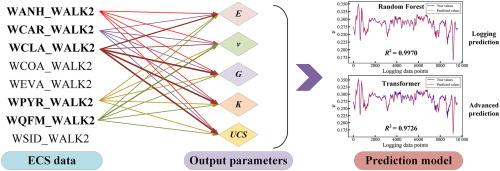Prediction on rock strength by mineral composition from machine learning of ECS logs
IF 3.6
引用次数: 0
Abstract
Rock strength evaluation is critical in oil and gas exploration, but traditional methods, such as empirical formulas, laboratory tests, and numerical simulations, often struggle with accuracy, generalizability, and alignment with field conditions. This study proposes the use of Random Forest and Transformer algorithms to predict rock strength from Elemental Capture Spectroscopy (ECS) logs. By utilizing the dry weight of minerals as input, the model predicts key mechanical properties, including Young's modulus, Poisson's ratio, bulk modulus, shear modulus, and uniaxial compressive strength. The findings demonstrate that mineral compositions, such as clay, quartz-feldspar-mica, carbonate, anhydrite, and pyrite, significantly influence rock strength. Specifically, clay content impacts Young's modulus, bulk modulus, and shear modulus, while quartz-feldspar-mica affects Poisson's ratio, and anhydrite is the primary factor influencing compressive strength. Positive correlations were observed between rock strength and the dry weight of anhydrite and carbonate minerals, while negative correlations emerged with clay, pyrite, and quartz-feldspar-mica. The Random Forest model outperformed the Transformer model in terms of predictive accuracy and computational efficiency. Its training time is only one three hundredth of the latter and its prediction time is just one tenth of the later, making it highly suitable for well-logging interpretation. Although the Transformer model was less computationally efficient, it exhibited strengths in predicting subsurface strength parameters, particularly in capturing spatial variations and forecasting these parameters across different spatial locations. This study introduces a novel AI-driven approach to rock strength evaluation, bridging the gap between mineral composition and mechanical properties, with significant implications for resource extraction and reservoir management.

通过对 ECS 测井记录的机器学习,根据矿物成分预测岩石强度
岩石强度评估在油气勘探中至关重要,但传统方法,如经验公式、实验室测试和数值模拟,往往难以达到准确性、通用性和与现场条件的一致性。本研究提出使用随机森林和变压器算法来预测元素捕获光谱(ECS)测井数据的岩石强度。通过使用矿物的干重作为输入,该模型预测关键的力学性能,包括杨氏模量、泊松比、体积模量、剪切模量和单轴抗压强度。研究结果表明,粘土、石英长石云母、碳酸盐、硬石膏和黄铁矿等矿物成分对岩石强度有显著影响。其中,粘土含量影响杨氏模量、体积模量和剪切模量,石英-长石-云母影响泊松比,硬石膏是影响抗压强度的主要因素。岩石强度与硬石膏、碳酸盐矿物干重呈正相关,与粘土、黄铁矿、石英长石云母呈负相关。随机森林模型在预测精度和计算效率方面优于Transformer模型。其训练时间仅为后者的1 / 300,预测时间仅为后者的1 / 10,非常适合于测井解释。虽然Transformer模型的计算效率较低,但它在预测地下强度参数方面表现出优势,特别是在捕捉空间变化和预测不同空间位置的这些参数方面。该研究引入了一种新的人工智能驱动的岩石强度评估方法,弥合了矿物成分和力学性质之间的差距,对资源开采和油藏管理具有重要意义。
本文章由计算机程序翻译,如有差异,请以英文原文为准。
求助全文
约1分钟内获得全文
求助全文

 求助内容:
求助内容: 应助结果提醒方式:
应助结果提醒方式:


